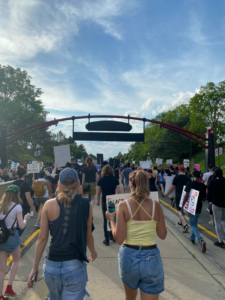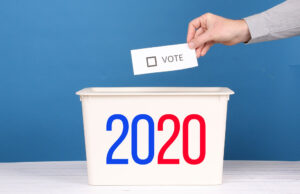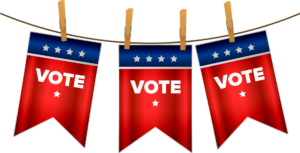
By Tia Lowe
For weeks, President Trump has been predicting the end of an American dream if his Democratic challenger is elected. “The suburbs would be gone, and you’d see problems like you’ve never seen before,” he said during the Sept. 29 televised debate.
The next day, Vice President Pence was in a suburb outside of Atlanta, boasting to a conference of white evangelical voters that his boss was “the most pro-life president in American history,” and pledging confirmation of Judge Amy Coney Barrett, a documented opponent of abortion rights, as the next associate justice on the U.S. Supreme Court. She now is on the court.
Pence spoke in Cobb County, whose voters repeatedly sent Republican Newt Gingrich to Congress, where he served as Speaker of the House from 1995-1999.
In the 2018 election, however, one of Gingrich’s GOP successors, Karen Handel, lost the seat to Democrat Lucy McBath, a Black former flight attendant whose son was murdered in a Florida parking lot six years earlier.
McBath had become not only a national symbol of the Black Lives Matter movement, but also a strong voice for the Moms Demand Action for Gun Sense in America coalition and the March for Our Lives protests that followed the killings at Marjory Stoneman Douglas High School in Parkland, a suburb of Miami.
Now McBath and Handel are in a tight re-run of their 2018 contest, and the Trump/Pence ticket is neck and neck with its Democratic rival, former Vice President Joseph R. Biden Jr. and Sen. Kamala D. Harris of California.
Suburban women are considered a pivotal voting group in Tuesday’s elections, and in Cobb County and on the outskirts of countless cities around the nation, one label doesn’t fit all.
For many suburban women, race can be equally or more important than gender in determining how they vote, and more important, too, than where they happen to live.
***
ONE EXCHANGE between the two presidential candidates forecast teachable moments. “He wouldn’t know a suburb unless he took a wrong turn,” Biden shot back at Trump, when the president made his fatalistic forecast on the future of life outside city limits.
Air Force One, the presidential plane, is housed at Joint Base Andrews, a military facility in Camp Springs, Maryland, a suburb just outside the Beltway, the proverbial interstate bypass that rings the nation’s capital, geographically and, many say, politically, as well.
Roads going west from the airfield lead to the White House, the Capitol and the Supreme Court. Roads north are gateways to and highways through Prince George’s County, a very different place than it was decades ago.
Once snubbed by some as a scruffy next-door neighbor to the District’s South and East, Prince George’s was no match for Montgomery County to the District’s North. Montgomery’s zip codes referred to addresses in Bethesda, Cabin John, Chevy Chase, Potomac, and Silver Spring. In Prince George’s, there was Bowie, Landover, Suitland and Upper Marlboro, the county seat.
“PG,” as some derided it, was a go-to place for many working-class Whites getting away from the District after the riots in 1968, as it was for many middle-class Blacks who left, too. Over time, however, Prince George’s has become a prestigious destination for affluent African Americans, and is now considered one of the nation’s premier family-friendly, majority-Black suburbs.
The county is home to several Black mega churches with thousands of members each, the 40,000-student flagship campus of the University of Maryland, NASA’s Goddard Space Flight Center, and FedEx Field, the 80,000-seat home stadium of Washington’s NFL football team. Prince George’s recently surpassed Montgomery as the top job creator among Maryland suburbs. More Black folks live in Prince George’s than in the District, and more than in Baltimore, as well.
Central cities and suburbs often are arch rivals on issues of state government; Prince George’s and the city of Baltimore, Maryland’s largest, more often are not. Their dependable votes, as well as those of other Black communities surrounding both urban centers, are at the core of the Democratic party’s dominance in Maryland politics.
***
PRINCE GEORGE’S is a mirror image of 21st-century suburban America . Around the nation, suburbs remain places of relative affluence. More poor people live in suburbs than in big cities, in part simply because more people live in suburbs than live in cities. The colors of the suburbs also are changing.
A study by the Brookings Institution found that “Whites comprised less than 10 percent of the growth of the suburban population to America’s 100 largest metros between the years 2000 and 2010.” Minorities accounted for 35 percent of the population growth in 36 of those 100 cities.
A few days ago, Trump popped this question at a rally in Johnstown, Pa., a city of 21,000 an hour’s drive east of Pittsburgh. “Suburban women, will you please like me? Please. Please,” he said. “I saved your damn neighborhood, OK?”
“I think we’re going to see that the women really like Trump a lot,” the President said, looking ahead to Tuesday’s election. “Four years ago, they said women will never vote for [me]. Then I got 52 percent.”
That was the truth, but not the whole truth. Exit polls from the 2016 general election indicated that Trump did win 52 percent of the votes of White women. Among Black women, the same polls reported, he won 4 percent.
There was a time when “suburbanization and racial tension in U.S. metro areas went hand-in-hand,” New York University history professor Tom Sugrue told Mother Jones earlier this year. “White suburbanites had a fear of the cities they were leaving. Law and order politics found very rich soil to grow in.”
Now, however, a majority of suburban women surveyed in New York Times/Siena College polls said it would not concern them “if new apartments, subsidized housing developments or new neighbors with government housing vouchers came to their neighborhoods. They also said, by a two-to-one margin, that they support government vouchers for lower-income families to live in more affluent committees.”
Crime, like poverty, has followed people to the suburbs. But so, too, have issues like those of police misconduct and accountability that are the focus of protests since the killing of George Floyd.
Mother Jones reported that, “a Monmouth University poll of registered voters conducted in the wake of the Floyd protests found 59 percent of women believed the police were more likely to mistreat Black people than white people, as did nearly half of white respondents—double the number who said so in July 2016.”
And, “an NBC News/Wall Street Journal poll found that 27 percent of white voters said they were more worried about the protests in which vandalism ensued than about Floyd’s and police conduct.”
George Floyd died under a policeman’s knee on a big-city street. But Michael Brown was killed by a policeman’s bullet in Ferguson, a suburb of St. Louis; and Trayvon Martin died in Sanford, Florida, a suburb of Orlando.
Jordan Davis was shot and killed in a big-city parking lot in Florida while visiting his father. His mother was a Cobb County suburban mom—Lucy McBath .
***
VICE PRESIDENT PENCE’S pro-life pitch in Cobb County was not coincidental. About one third of all evangelicals in the nation live in suburbs, three of every four suburban evangelicals identify as Republicans, and evangelical voters have been especially critical to Republican candidates in the South.
Just three years ago in Alabama, Roy Moore was the Republican nominee in the contest to fill the remainder of the U.S. Senate term of Jeff Sessions, who had stepped aside to become Attorney General in the Trump administration.
Moore ran under a cloud of allegations of sexual assault, yet, exit polls showed, 80 percent of White voters who identified as evangelicals voted for him. Among whites who did not identify as evangelicals or born-again Christians, about the same proportion, 76 percent, did not vote for Moore, and backed Democrat Doug Jones instead.
Exit polls also indicated that 95 percent of Black voters who identified as evangelical or born again voted for Jones—about the same as the 98 percent of Black non-evangelicals who supported him, The Washington Post reported. Both Moore and Jones are White.
“The exit poll results echoed the overwhelming loyalty that White evangelical Christians across the nation showed the Republican Party during the 2016 election,” HuffPost reported, “when about 81 percent voted for President Donald Trump.”
***
ABORTION IS NOT the same issue to voters Black or White, male or female, city or suburban. Nationally, Black women have the highest abortion rate—27 per 1,000 versus 10 for White women. But in Black communities, other concerns factor in: the quality of the schools and of health care, as well as jobs, incarceration rates, and maternal and infant mortality.
Kawanna Shannon directs surgical services at a health clinic run by the Reproductive Health Services of Planned Parenthood of the St. Louis Region. At one point last year, state officials temporarily banned the clinic from performing some abortions.
Black women—and she is one—already have enough challenges, she told The New York Times. “And now I have to still deal with the state and the governor now passing laws and telling me what I can and can’t do with my own body,” Shannon said. “It’s just burdensome.”
Cessilye Smith, like Shannon, is Black, but an opponent of abortion. The Times described her as working to open a free clinic to provide pre- and post-natal care and other services for women. “We can save a child in the womb, but we also have an environment that could kill that child. They both have to be worked on equally,” Smith said.
Such reasoning can make race a political fault line for some Black religious leaders.
“Those who are most vocal about abortion and abortion laws are my white brothers and sisters, and yet many of them don’t care about the plight of the poor, the plight of the immigrant, the plight of African-Americans,” the Rev. Luke Bobo, an anti-abortion minister from Kansas City, Mo., told The Times. “My argument here is, let’s think about the entire life span of the person.”
“As much as I believe with all my heart about the killing, the taking of innocent lives,” said the Rev. Clinton Stancil, pastor of Wayman AME Church in St. Louis, “I also believe that I will never support giving white legislators who have no interest in our community the ability to tell our women what they can do with their bodies.”
***
TODAY’S COBB COUNTY is not Newt Gingrich’s Cobb County. In 1980, two decades before his time in Congress ended, 5 percent of the county’s residents were Black. Today, two decades after Gingrich left Capitol Hill, the county’s population is 27 percent Black and 13 percent Hispanic.
When McBath was first elected two years ago, 51,000 Black women voted in Cobb—20,000 more than four years earlier. Unopposed in this year’s Democratic primary, McBath still received 26,000 more votes than the combined total for all five candidates in the Republican primary.
Black Democrats have not been the only victors in county government. The district attorney and a deputy sheriff both are Republicans. Both are women; both are Black.
President Trump visited the county in early September and made a special pitch to Black voters, promising loans for Black-owned businesses and pledging to enact an anti-lynching law.
“Racial justice begins with Joe Biden’s retirement from public life,” he told his audience. “What the hell do you have to lose?”
Republicans haven’t lost a presidential race in Georgia since 1992, when Democrat Bill Clinton defeated incumbent George H.W. Bush. Polls in the state indicate that 9 of 10 Black voters support Biden, and only one in 20 backs Trump. The state has 16 electoral votes, and the presidential race is forecast to be close, right down to the end.


